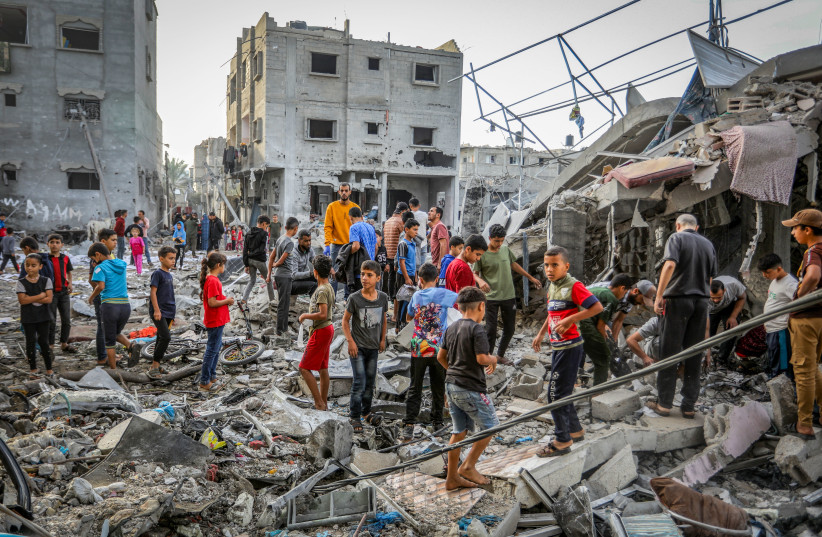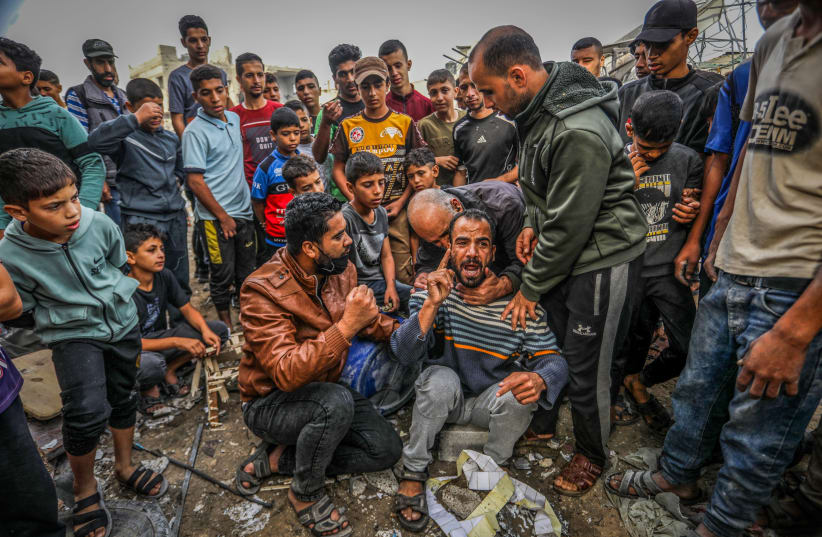Prime Minister Benjamin Netanyahu has acknowledged an Israeli security role in Gaza after the war for an undetermined length of time but demurred on who will govern. In 2005, Israel withdrew all forces from Gaza, marking an end to an occupation that began at the close of the Six-Day War in 1967.
Israel holds no ambition to reestablish a long-term presence in Gaza. No one in the region does – not even neighboring Egypt. Any Arab state coming in behind Israeli forces and presiding over a ruined Gaza will face wrath and perhaps an insurgency at home.
Officials in Washington, the UN, and across the Middle East are developing strategies for managing a post-Hamas Gaza. The possible scenarios involve geopolitical complexities, massive humanitarian challenges, unspoken global economics, and fraught decisions. There are no easy answers along the glide path to a new political and social order and stark geopolitical consequences for missteps are likely.
After Hamas, Gaza’s population will live in ruins with few essential services. The size of that post-war population is unclear: many thousands of Gazans have been killed, and many more will die in the ongoing fighting. A sizeable, unknown number will be displaced and will not return. A seething hatred of Israelis will consume much of the surviving population. With Hamas out, a power vacuum will emerge with ramifications across the region for generations.
An Israeli occupation of Gaza will introduce a set of responsibilities and legal obligations under the Hague Convention, including governance and civil services. However, Israel has no interest in assuming such burdens in the face of the international community – an indefinite Israeli presence following the conflict runs counter to Jerusalem’s objectives. It would cast Israel as the de facto occupier of Gaza, a role it is unwilling to assume.


Establishing buffer zones secured by IDF troops or regional forces might offer temporary stability, but this is not a viable, enduring solution and does not address the internal governance vacuum. Buffer zones would also represent a challenge to providing security from above and below the ground, as well as from ground-based rockets and drone strikes.
Life in Gaza after the military defeat of Hamas must include a capable governance structure that can ensure peace – or some semblance of it, facilitate reconstruction, and manage civil affairs while limiting the potential for renewed hostilities. A post-Hamas Gaza must also consider the geographical and political separation from the West Bank while aligning with broader regional peace efforts and the overall objectives of the Palestinian people.
HAMAS, ORIGINALLY an offshoot of the Palestinian Muslim Brotherhood, became the governing authority in the Gaza Strip following its victory over the rival faction Fatah in the 2006 elections. Since then, the closure of border crossings by Israel and Egypt, as well as support by Iran, has allowed Hamas to dominate all levels of governance, society, and security inside Gaza. Hamas has since become the political actor for residents in the Strip.
Post-Hamas Gaza
To date, US and Israeli leadership offer only vague suggestions about a post-Hamas Gaza. While the annihilation of Hamas may be an objective, it cannot be the endgame. Accordingly, Israel and the US must think deeply about the next steps now to avoid a governance void that will create the opportunity for a group even more violent and extreme than Hamas. For example, Palestinian Islamic Jihad is the second-largest militant group in the Gaza Strip and receives support from Iran, Syria, and Hezbollah.
Israel’s siege, aimed at eradicating Hamas, will dismantle an entire administrative framework that governs everyday life. Hamas has established a cruel, oppressive government that severely constrains the political rights and civil liberties of Gazans.
Nevertheless, it has provided some measure of essential services. For example, Gaza’s children receive a stifled, Hamas-programmed education. Some form of schooling will have to take its place. Erasing Hamas’s military wing does not simply erase the need for such social institutions. The fighting to come will only exacerbate the desperation for them.
The humanitarian crisis in Gaza is dire now. The death toll of more than 9,000 will surely increase. Gaza resembles a dystopian hellscape. The UN warns of a catastrophe to come. Those trapped in Gaza must also face a deadly scarcity of medicine, functioning hospitals, and drinkable water. Despite the IDF’s evacuation warnings, many Gazans remain trapped in the north.
Hamas has instructed civilians to remain in place, saying the roads are unsafe. Meanwhile, Israeli officials say Hamas deliberately keeps civilians in harm’s way to be used as human shields.
DELIBERATIONS ON potential annexation floated by right-wing Israeli lawmakers, resurrect memories of past Palestinian grievances and hint at controversial changes in the region’s geography. Yet, US Secretary of State Antony Blinken and Israeli Ambassador to the US Michael Herzog dismissed the notion of reoccupation. Public rejection of such a move speaks to the unwanted burden of administering Gaza post-war.
In the immediate aftermath of the war, the IDF must maintain a presence in Gaza as a means to suppress the resurgence of Hamas, provide stability for the strip, and guard against the rise of Palestinian Islamic Jihad or some other terror group. Here, too, there is risk. The image of the IDF as an occupying force presiding over a devastated Gaza may lead to resistance and further conflict. Hamas is an Arabic acronym meaning “Islamic Resistance Movement.” By the time Hamas is vanquished, the term may grow to a call for “resistance” against Israel by all Palestinians.
The absence of Hamas will not sustain peace. Stability in Gaza will require an inclusive political process, one that can bridge the deep divisions across the region and provide a unifying framework for all Palestinians. Any framework for stability must work within a part of the world in which distrust is deep-seated and past grievances run deep.
The international community must determine who will step in to govern. The Palestinian Authority, seen by some as a potential administrator, faces credibility issues, and without broad support, any attempt to manage could lead to further fragmentation.
Moreover, the reconstruction of Gaza is an international concern. The world has witnessed the horrors unfold in real-time, and there will be an expectation for a robust and coordinated effort to rebuild, not just in bricks and mortar but in restoring a semblance of normalcy for the people who have endured decades of conflict.
An international peacekeeping force providing security under UN authority that allows the Red Cross, UNICEF, Doctors Without Borders, and other aid groups to provide essential services must be ready for the immediate post-conflict fallout. After that, a Palestinian Authority backed by leadership across the Middle East, including the Kingdom of Saudi Arabia, may be a viable option.
Established in the mid-1990s, the PA has administered segments of the West Bank under Israeli occupation with the initial aim of leading the path toward an autonomous Palestinian nation. However, it is now widely regarded as an authoritarian entity beleaguered by corruption and impotence, propped up by the European Union and others, and under the influence of the IDF.
The road ahead for Gaza is fraught with challenges. After Hamas, what comes next in Gaza will depend not only on the strategies of war but on the moral fortitude of those at the helm of its aftermath. The people of Gaza, who have known little but conflict, deserve a chapter in their history that offers an opportunity for peace and reconstruction.
The writer is a retired US Army Colonel who most recently served as US Central Command Communications Director from 2021 to August 2023. He deployed to combat in the Middle East five times during his career. He now serves as an AI analyst.
